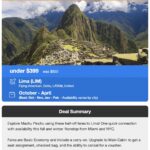Are you planning a European adventure and wondering what to wear? Don’t stress! Figuring out What To Wear When Traveling To Europe can be tricky, but with careful planning, you can create a versatile and stylish travel wardrobe. TRAVELS.EDU.VN is here to guide you through selecting the perfect clothing items for your trip, ensuring you’re prepared for any weather, activity, or occasion. This comprehensive guide will help you pack efficiently, stay comfortable, and look fantastic while exploring the diverse cultures and landscapes of Europe, while taking into account factors like climate, cultural norms, and activities. With tips on essential items, layering, and destination-specific advice, we’ll make sure you’re ready to experience Europe in style and comfort. We’ll delve into capsule wardrobes, travel essentials, and offer packing tips tailored to different European destinations, including insights into weather patterns, cultural norms, and practical considerations.
1. Understanding Europe’s Diverse Climates
Europe is a continent of varied climates, from the mild Mediterranean to the chilly Nordic regions. Before you even think about outfits, understanding the weather patterns of the places you’ll visit is critical.
1.1. Mediterranean Climate (Southern Europe)
Think of sunny skies, warm temperatures, and low rainfall during the summer months (June to August). Cities like Rome, Athens, and Barcelona experience average temperatures ranging from 70°F to 90°F (21°C to 32°C). During the shoulder seasons (April-May & September-October), temperatures are milder, ranging from 50°F to 70°F (10°C to 21°C), with occasional rain.
What to Pack:
- Lightweight fabrics (linen, cotton)
- Sunscreen and a hat
- Comfortable walking shoes
- Swimwear for coastal destinations
- A light jacket for cooler evenings
1.2. Continental Climate (Central Europe)
Cities like Paris, Berlin, and Vienna experience warm summers and cold winters. Summer temperatures average between 60°F and 80°F (15°C to 27°C), while winter temperatures can drop below freezing. Rainfall is fairly consistent throughout the year.
What to Pack:
- Layers, layers, layers
- A versatile jacket (trench coat or leather jacket)
- Comfortable walking shoes
- An umbrella or raincoat
- Warm accessories (scarf, gloves, hat) for winter
1.3. Maritime Climate (Western Europe)
London, Dublin, and Amsterdam have mild temperatures year-round with frequent rainfall. Summer temperatures average between 60°F and 70°F (15°C to 21°C), while winter temperatures rarely drop below freezing.
What to Pack:
- Waterproof outerwear
- Layers
- Comfortable walking shoes that can handle wet conditions
- An umbrella
- Sweaters and cardigans
1.4. Nordic Climate (Northern Europe)
Cities like Stockholm, Oslo, and Helsinki have short, cool summers and long, cold winters. Summer temperatures average between 50°F and 70°F (10°C to 21°C), while winter temperatures can drop well below freezing.
What to Pack:
- Heavy winter coat
- Thermal layers
- Waterproof and insulated boots
- Warm accessories (scarf, gloves, hat)
- Sweaters and cardigans
2. Defining Your Travel Style And Activities
Before you start throwing clothes into your suitcase, consider the type of trip you’re planning. Will you be hiking in the Swiss Alps, exploring museums in Florence, or attending a business conference in Berlin? Your activities will heavily influence your wardrobe choices.
2.1. City Exploration
For exploring cities, comfort and style are key. You’ll want to be able to walk for miles without your feet aching, but you’ll also want to look presentable when visiting historical sites or dining at local restaurants.
Recommended Outfits:
- Comfortable Walking Shoes: Essential for navigating cobblestone streets and long museum visits.
- Versatile Pants or Jeans: Choose a pair that can be dressed up or down.
- Layerable Tops: T-shirts, blouses, and sweaters that can be mixed and matched.
- Lightweight Jacket: A trench coat, denim jacket, or blazer for cooler days.
- Crossbody Bag: Secure and convenient for carrying essentials.
2.2. Outdoor Adventures
If your trip involves hiking, camping, or other outdoor activities, you’ll need practical and durable clothing.
Recommended Outfits:
- Moisture-Wicking Base Layers: To keep you dry and comfortable.
- Insulating Mid-Layers: Fleece jackets or sweaters for warmth.
- Waterproof and Windproof Outer Layer: A durable jacket to protect you from the elements.
- Hiking Pants or Shorts: Depending on the climate.
- Sturdy Hiking Boots: With good ankle support.
- Hat and Gloves: For warmth in colder climates.
2.3. Cultural Immersion
For those interested in experiencing local culture, you’ll want to dress respectfully and appropriately for the customs of the countries you’re visiting.
Recommended Outfits:
- Modest Clothing: In some countries, it’s important to cover your shoulders and knees when visiting religious sites.
- Comfortable Shoes: For walking and standing.
- Versatile Accessories: Scarves, hats, and jewelry to add a touch of local flair.
- Neutral Colors: Easy to mix and match and less likely to offend.
2.4. Business Travel
If you’re traveling to Europe for business, you’ll need professional attire that is both stylish and comfortable.
Recommended Outfits:
- Business Suits: Classic and appropriate for most meetings.
- Dress Shirts and Blouses: In neutral colors.
- Dress Pants or Skirts: Depending on your preference.
- Blazers: Versatile for layering.
- Comfortable Dress Shoes: For long days of meetings.
- A Stylish Briefcase or Laptop Bag: To carry your essentials.
3. Building Your Essential European Travel Wardrobe
Now that you know about Europe’s climates and have considered your travel style, let’s build a capsule wardrobe that will keep you comfortable and stylish throughout your trip.
3.1. Core Clothing Items
These are the foundational pieces that you’ll build your outfits around.
- Pants: 2-3 pairs of versatile pants (jeans, chinos, or dress pants)
- Tops: 4-5 tops (T-shirts, blouses, or sweaters)
- Dress/Skirt: 1-2 versatile dresses or skirts that can be dressed up or down
- Outerwear: 1-2 jackets (a lightweight jacket and a heavier coat, depending on the climate)
- Shoes: 2-3 pairs of comfortable shoes (sneakers, walking shoes, and dress shoes)
3.2. Layering Pieces
Layering is essential for adapting to changing weather conditions.
- Cardigan or Sweater: For adding warmth on cooler days.
- Scarf: A versatile accessory that can add warmth and style.
- Base Layers: Thermal underwear for cold climates.
3.3. Accessories
Accessories can elevate your outfits and add personal style.
- Jewelry: Simple and versatile pieces that can be worn with multiple outfits.
- Sunglasses: To protect your eyes from the sun.
- Hat: For sun protection or warmth.
- Gloves: For cold climates.
- Belt: To cinch your waist and add polish.
3.4. Undergarments And Socks
Don’t forget the essentials!
- Underwear: Enough for the duration of your trip.
- Socks: A mix of regular and thermal socks, depending on the climate.
- Bras: Comfortable and supportive bras.
4. Selecting The Right Fabrics
The fabrics you choose can make a big difference in your comfort level.
4.1. Breathable Fabrics
- Cotton: A natural fiber that is breathable and comfortable.
- Linen: A lightweight fabric that is perfect for warm weather.
- Merino Wool: A natural fiber that is breathable, moisture-wicking, and odor-resistant.
4.2. Quick-Drying Fabrics
- Polyester: A synthetic fabric that is durable and quick-drying.
- Nylon: A synthetic fabric that is strong and water-resistant.
- Microfiber: A synthetic fabric that is soft, lightweight, and quick-drying.
4.3. Insulating Fabrics
- Fleece: A synthetic fabric that is warm and cozy.
- Down: A natural insulator that is lightweight and compressible.
5. Packing Tips For Efficiency
Packing efficiently can save you space and make your trip more enjoyable.
5.1. Roll Your Clothes
Rolling your clothes instead of folding them can save space and reduce wrinkles.
5.2. Use Packing Cubes
Packing cubes can help you organize your clothes and compress them, saving space.
5.3. Wear Your Bulkiest Items
Wear your bulkiest shoes and jacket on the plane to save space in your suitcase.
5.4. Utilize Empty Space
Fill empty space in your shoes with socks or other small items.
5.5. Limit Shoes
Shoes take up a lot of space, so limit yourself to 2-3 pairs.
6. Destination-Specific Packing Advice
Different European destinations have different climates, cultures, and activities. Here’s some destination-specific packing advice:
6.1. Paris, France
Paris is known for its chic style, so pack sophisticated and stylish outfits.
- Key Items: Trench coat, classic dresses, stylish flats or heels, and a scarf.
- Weather Considerations: Paris has a temperate climate with mild winters and warm summers, so pack layers.
6.2. Rome, Italy
Rome has a warm Mediterranean climate, so pack lightweight and breathable clothing.
- Key Items: Comfortable walking shoes, lightweight dresses, linen pants, and a hat for sun protection.
- Weather Considerations: Summers in Rome can be hot and sunny, so pack sunscreen and a hat.
6.3. London, United Kingdom
London has a maritime climate with frequent rainfall, so pack waterproof outerwear and comfortable shoes that can handle wet conditions.
- Key Items: Waterproof jacket, comfortable walking shoes, layers, and an umbrella.
- Weather Considerations: London’s weather is unpredictable, so be prepared for rain at any time of year.
6.4. Barcelona, Spain
Barcelona has a Mediterranean climate with warm summers and mild winters, so pack lightweight clothing and swimwear.
- Key Items: Comfortable walking shoes, lightweight dresses, swimwear, and a hat for sun protection.
- Weather Considerations: Summers in Barcelona can be hot and sunny, so pack sunscreen and a hat.
6.5. Amsterdam, Netherlands
Amsterdam has a maritime climate with mild temperatures and frequent rainfall, so pack waterproof outerwear and comfortable shoes that can handle wet conditions.
- Key Items: Waterproof jacket, comfortable walking shoes, layers, and an umbrella.
- Weather Considerations: Amsterdam’s weather is unpredictable, so be prepared for rain at any time of year.
 travel day outfit leggings and trench
travel day outfit leggings and trench
Alt text: Travel outfit featuring leggings, a sweatshirt, trench coat, and Chelsea boots, perfect for comfortable travel.
7. What Not To Pack
There are certain items that you can leave at home.
7.1. Uncomfortable Shoes
Europe is a walking-intensive destination, so leave your uncomfortable shoes at home.
7.2. Too Many Clothes
Overpacking is a common mistake, so edit your wardrobe and only bring what you need.
7.3. Bulky Electronics
Leave your bulky electronics at home and rely on your smartphone or tablet for entertainment.
7.4. Expensive Jewelry
Avoid bringing expensive jewelry that could attract unwanted attention.
7.5. Anything You Wouldn’t Be Devastated To Lose
Travel can be unpredictable, so don’t bring anything you wouldn’t be devastated to lose.
8. The Importance Of Comfortable Footwear
Footwear is one of the most important aspects of your travel wardrobe. Here’s why comfort reigns supreme and some top recommendations.
8.1. Prioritizing Comfort
When you’re exploring Europe, you’ll likely be doing a lot of walking. Cobblestone streets, long museum lines, and spontaneous adventures require shoes that can keep up.
8.2. Recommended Brands
- Ecco: Known for their comfortable and supportive walking shoes.
- Allbirds: Offers lightweight and sustainable sneakers made from merino wool.
- Blundstone: Durable and stylish boots that are perfect for all-weather conditions.
- Superga: Classic canvas sneakers that are comfortable and versatile.
8.3. Insoles
Consider adding insoles to your shoes for extra support and cushioning.
9. Staying Stylish On The Go
Looking good doesn’t have to come at the expense of comfort.
9.1. Accessorize
Accessories can elevate your outfits and add personal style.
9.2. Choose Versatile Pieces
Choose clothing items that can be dressed up or down.
9.3. Pay Attention To Fit
Well-fitting clothes will always look more stylish than baggy or ill-fitting clothes.
9.4. Embrace Local Fashion
Take inspiration from local fashion and incorporate it into your wardrobe.
 linen pants with trench and striped shirt
linen pants with trench and striped shirt
Alt text: A stylish outfit with linen pants, a striped shirt, and a trench coat, ideal for exploring European cities.
10. Practical Considerations
Beyond the fashion aspects, consider these practical tips for a smooth trip.
10.1. Travel Insurance
Protect yourself with travel insurance that covers medical expenses, lost luggage, and trip cancellations.
10.2. Adapters
Europe uses different electrical outlets than the United States, so bring a universal adapter.
10.3. Money Belt
Keep your valuables safe with a money belt or hidden pocket.
10.4. Copies Of Important Documents
Make copies of your passport, driver’s license, and other important documents and store them separately from the originals.
10.5. Learn Basic Phrases
Learning a few basic phrases in the local language can go a long way.
11. Navigating Cultural Norms
Understanding and respecting local customs is crucial for a positive travel experience.
11.1. Dress Codes
Some religious sites require modest dress, so be prepared to cover your shoulders and knees.
11.2. Tipping
Tipping customs vary from country to country, so do your research before you go.
11.3. Greetings
Learn how to greet people properly in the local language.
11.4. Dining Etiquette
Familiarize yourself with local dining etiquette, such as which utensils to use and how to signal that you’re finished eating.
12. How TRAVELS.EDU.VN Can Help You Plan Your European Wardrobe
At TRAVELS.EDU.VN, we understand the challenges of planning the perfect travel wardrobe. That’s why we offer personalized styling services to help you create a capsule wardrobe that fits your travel style, destination, and budget.
12.1. Personalized Styling Services
Our expert stylists will work with you to create a customized packing list and outfit recommendations based on your travel plans.
12.2. Packing List Templates
We offer a variety of packing list templates that you can customize to fit your needs.
12.3. Travel Gear Reviews
We provide honest and unbiased reviews of travel gear to help you make informed decisions.
13. Tips For Sustainable Travel
Traveling sustainably can help protect the environment and support local communities.
13.1. Pack Light
Packing light reduces your carbon footprint and saves on baggage fees.
13.2. Choose Eco-Friendly Products
Choose travel-sized toiletries and other products that are eco-friendly.
13.3. Support Local Businesses
Shop at local markets and eat at local restaurants to support the local economy.
13.4. Respect The Environment
Avoid littering and stay on marked trails to protect the environment.
14. Planning For Unexpected Weather
Even with careful planning, the weather can be unpredictable.
14.1. Check The Forecast
Check the weather forecast regularly and adjust your wardrobe accordingly.
14.2. Pack Versatile Layers
Layers can help you adapt to changing weather conditions.
14.3. Be Prepared For Rain
Always be prepared for rain, even if the forecast is clear.
15. Budget-Friendly Packing Tips
Traveling to Europe doesn’t have to break the bank.
15.1. Shop Your Closet
Shop your closet first and see what you already have that you can use.
15.2. Buy Versatile Pieces
Buy clothing items that can be worn in multiple ways.
15.3. Look For Sales
Look for sales and discounts on travel gear and clothing.
16. Creating Outfits For Different Occasions
Having a few go-to outfits for different occasions can make packing easier.
16.1. Casual Day Outfit
Jeans, a T-shirt, sneakers, and a lightweight jacket.
16.2. Dressy Evening Outfit
A dress or skirt, heels or flats, and jewelry.
16.3. Outdoor Adventure Outfit
Hiking pants, a moisture-wicking base layer, a fleece jacket, and hiking boots.
 leather pants with trench coat
leather pants with trench coat
Alt text: A chic ensemble featuring leather pants, a cashmere sweater, and a trench coat, suitable for stylish urban exploration.
17. Real-Life European Packing Examples
Let’s look at some real-life packing examples for different types of trips.
17.1. Backpacking Trip
- Backpack: Osprey Atmos AG 65
- Clothes: 3 T-shirts, 1 pair of jeans, 1 pair of hiking pants, 1 fleece jacket, 1 waterproof jacket, 1 pair of hiking boots, 1 pair of sandals
- Accessories: Hat, gloves, scarf, sunglasses
- Toiletries: Travel-sized toiletries
- Other: Travel towel, first-aid kit, headlamp
17.2. Luxury Vacation
- Suitcase: Tumi Vapor Lite
- Clothes: 3 dresses, 2 skirts, 4 tops, 1 pair of dress pants, 1 blazer, 1 trench coat, 1 pair of heels, 1 pair of flats
- Accessories: Jewelry, sunglasses, hat
- Toiletries: Full-sized toiletries
- Other: Camera, travel pillow
17.3. Business Trip
- Carry-on Suitcase: Briggs & Riley Baseline
- Clothes: 2 suits, 5 dress shirts, 2 pairs of dress pants, 1 blazer, 1 trench coat, 1 pair of dress shoes
- Accessories: Tie, belt, cufflinks
- Toiletries: Travel-sized toiletries
- Other: Laptop, tablet, business cards
18. Addressing Common Packing Concerns
Let’s address some common packing concerns.
18.1. What If I Forget Something?
Don’t worry! You can always buy what you need when you arrive at your destination.
18.2. How Do I Pack For Multiple Climates?
Pack versatile layers that can be mixed and matched.
18.3. How Do I Keep My Clothes From Wrinkling?
Roll your clothes instead of folding them and use packing cubes.
19. Essential Gadgets For Your Trip
Maximize your travel experience with these essential gadgets.
19.1. Portable Charger
Keep your devices charged on the go with a portable charger.
19.2. Universal Adapter
Europe uses different electrical outlets than the United States, so bring a universal adapter.
19.3. Noise-Cancelling Headphones
Enjoy peace and quiet on long flights or train rides with noise-cancelling headphones.
20. The Psychology Of Packing
Packing can be stressful, but it doesn’t have to be.
20.1. Start Early
Start packing early so you don’t feel rushed.
20.2. Make A List
Make a list of everything you need to pack.
20.3. Visualize Your Trip
Visualize your trip and imagine what you’ll be doing each day.
20.4. Don’t Overthink It
Don’t overthink it! Just pack what you need and have fun.
Planning what to wear when traveling to Europe doesn’t have to be daunting. By considering the climate, your activities, and packing efficiently, you can create a versatile wardrobe that will keep you comfortable and stylish throughout your trip. Remember to prioritize comfort, respect local customs, and have fun exploring the diverse cultures and landscapes of Europe.
Ready to plan your European adventure? Let TRAVELS.EDU.VN help you create the perfect travel wardrobe. Contact us today for personalized styling services and expert advice. Visit our website at TRAVELS.EDU.VN or call us at +1 (707) 257-5400. Our office is located at 123 Main St, Napa, CA 94559, United States. Let us take the stress out of packing so you can focus on enjoying your trip. Reach out via WhatsApp for immediate assistance!
FAQ: What to Wear When Traveling to Europe
1. What are the essential clothing items to pack for a trip to Europe?
The essential clothing items to pack for a trip to Europe include versatile pants (jeans, chinos), 4-5 tops (T-shirts, blouses, sweaters), a versatile dress or skirt, 1-2 jackets (lightweight and heavier), and 2-3 pairs of comfortable shoes (sneakers, walking shoes, dress shoes). These items can be mixed and matched to create a variety of outfits suitable for different occasions. Don’t forget layering pieces like cardigans and scarves to adapt to changing weather conditions.
2. How can I dress stylishly while also being comfortable for walking long distances in Europe?
To dress stylishly while being comfortable for walking long distances in Europe, prioritize comfortable footwear such as Ecco sneakers or Allbirds. Choose versatile pieces that can be dressed up or down, like jeans or chinos paired with layerable tops. Accessorize with scarves, hats, and jewelry to add personal style without sacrificing comfort. Paying attention to fit ensures that your clothes look polished while still allowing for ease of movement.
3. What type of outerwear should I pack for a trip to Europe with unpredictable weather?
For a trip to Europe with unpredictable weather, pack a waterproof jacket and a versatile trench coat. These can be layered together for extra warmth or worn separately depending on the conditions. A waterproof jacket will protect you from rain, while a trench coat adds a touch of style and can be dressed up or down. Ensure your outerwear is lightweight and easy to pack when not in use.
4. How should I pack for a trip to Europe that includes both city exploration and outdoor activities?
Pack versatile clothing items that can be adapted for both city exploration and outdoor activities. Include moisture-wicking base layers, insulating mid-layers (like fleece jackets), and a waterproof outer layer for outdoor activities. For city exploration, bring comfortable walking shoes, versatile pants or jeans, and layerable tops. A lightweight jacket and a crossbody bag are also essential.
5. What are some culturally appropriate clothing options for visiting religious sites in Europe?
When visiting religious sites in Europe, dress modestly to show respect. Opt for clothing that covers your shoulders and knees. Long skirts, dresses, and tops with sleeves are good choices. Carry a scarf to cover your head if required. Avoid wearing overly revealing or tight-fitting clothing.
6. How can I pack efficiently to save space in my luggage for a trip to Europe?
To pack efficiently and save space, roll your clothes instead of folding them, use packing cubes to compress and organize items, and wear your bulkiest shoes and jacket on the plane. Utilize empty space inside shoes for socks or small items. Limit the number of shoes to 2-3 pairs and choose versatile clothing items that can be worn in multiple ways.
7. What are the best fabrics to choose for clothing when traveling to Europe?
The best fabrics for clothing when traveling to Europe include breathable options like cotton and linen, especially for warm weather. Merino wool is excellent for its moisture-wicking and odor-resistant properties. For quick-drying and durable options, consider polyester, nylon, and microfiber. Fleece and down are ideal for insulating in colder climates.
8. Are there specific clothing items I should avoid packing for a trip to Europe?
Avoid packing uncomfortable shoes, too many clothes, bulky electronics, expensive jewelry, and anything you would be devastated to lose. Overpacking is a common mistake, so edit your wardrobe and only bring what you need. Uncomfortable shoes can ruin your trip, so prioritize comfort.
9. How can TRAVELS.EDU.VN help me plan my European travel wardrobe?
TRAVELS.EDU.VN offers personalized styling services to help you create a capsule wardrobe tailored to your travel style, destination, and budget. Our expert stylists can create customized packing lists and outfit recommendations. We also provide packing list templates and unbiased travel gear reviews to help you make informed decisions. Contact us at +1 (707) 257-5400 or visit travels.edu.vn for more information. Our office is located at 123 Main St, Napa, CA 94559, United States.
10. What are some essential gadgets to bring on my trip to Europe?
Essential gadgets for a trip to Europe include a portable charger to keep your devices powered, a universal adapter to accommodate different electrical outlets, and noise-cancelling headphones for comfortable travel. These gadgets can enhance your travel experience and ensure you stay connected and comfortable throughout your trip.
